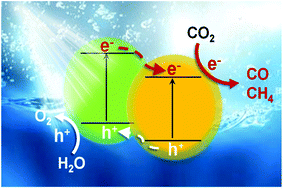TiO2-based heterojunction photocatalysts for photocatalytic reduction of CO2 into solar fuels
Abstract
In the twenty-first century, global warming and energy shortage have become major global issues. Up to now, the utilization of CO2 as a carbon source for the production of fuels and chemicals has received increased attention. The photocatalytic reduction of CO2 into solar fuels has turned out to become one of the most promising and environmentally friendly methods. Well-defined heterojunction structures between two semiconductors with matching electronic band structures can effectively facilitate charge transfer and suppress the recombination of photogenerated electrons and holes, resulting in enhanced photocatalytic performance. This review focuses on the design and fabrication of TiO2-based heterojunction photocatalysts and their recent progresses into developing solar fuels via the photocatalytic reduction of CO2. The photocatalytic performances of a number of typical TiO2-based heterojunction photocatalysts, e.g., p–n, non-p–n, Z-scheme, TiO2–metal, TiO2–carbon, phase, facet, and other heterojunctions, are summarized and analyzed. The reaction mode and some typical photoreactors, e.g., slurry photoreactor, optical-fiber photoreactor, monolith photoreactor, and optofluidic microreactor, are also presented and analyzed. In the end, we propose a perspective on the opportunities and challenges to design new types of photocatalysts and photoreactors for improving the photocatalytic reduction of CO2.



 Please wait while we load your content...
Please wait while we load your content...